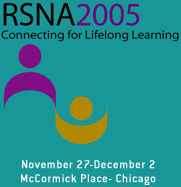
Abstract Archives of the RSNA, 2005
SSK06-07
Comparison of Microvascular Morphological Changes in Hepatocellular Carcinomas Using Micro Flow Imaging with Pathologic Findings in a Multicenter Trial
Scientific Papers
Presented on November 30, 2005
Presented as part of SSK06: ISP: Ultrasound (Liver: Contrast)
Fuminori Moriyasu MD,PHD, Presenter: Nothing to Disclose
Ming De Lu, Abstract Co-Author: Nothing to Disclose
Min Hua Chen MD, Abstract Co-Author: Nothing to Disclose
Xiao Dong Zhou MD, Abstract Co-Author: Nothing to Disclose
Yuxin Jiang MD, Abstract Co-Author: Nothing to Disclose
Hiroko Iijima, Abstract Co-Author: Nothing to Disclose
Naohisa Kamiyama PhD, Abstract Co-Author: Nothing to Disclose
Akihiro Sano MS, Abstract Co-Author: Nothing to Disclose
et al, Abstract Co-Author: Nothing to Disclose
We attempted to evaluate microvascular changes of hepatocellular carcinomas (HCCs) using SonoVue and a new contrast technique, Micro Flow Imaging (MFI) by means of morphological changes seen in HCCs on MFI and histopathological findings. We ultimately aimed to clarify whether this new method could be used for diagnosis of histological differentiation.
Four sites from China and one site from Japan participated in this protocol. We enrolled all 120 patients of liver tumors, mainly HCC. The analysis was performed in 43 patients out of these in whom both MFI and pathological evaluation was performed based on as from biopsy or surgical specimens.
The ultrasound contrast agent was SonoVue. 2.4 mL of SonoVue was injected intravenously two times. One injection was for a dynamic study using low mechanical index (MI) phase inversion harmonic imaging and the other was for MFI. MFI is accumulated imaging using the maximum folding technique following several flash scanning flames with a high MI ultrasound exposure. The ultrasound equipment used was Toshiba Aplio and the transducer used was a convex type, 375BT with a central frequency of 3.75 MHz.
The pathological diagnosis was well differentiated HCC (well HCC) in 8, moderately differentiated HCC (mod. HCC) in 27 and poorly differentiated HCC (poor HCC) in 8. Morphological findings were divided into three patterns 1) cotton pattern- no thick blood vessels and cotton wool staining; 2) vascular and cotton pattern- continuous vascular images and cotton staining; 3) clubbed vascular pattern- clubbed vessels with fewer branches and heterogeneous staining. Findings were evaluated by 3 investigators blinded as regards the pathological findings. Cotton pattern was most frequently seen in well HCCs (4/8), vascular and cotton pattern in mod. HCCs (22/27) and clubbed vascular pattern in poor HCCs (7/8). The overall diagnostic accuracy was 77% when these criteria were applied to HCC diagnosis.
Microvascular morphology of HCC was visualized using MFI. Microvascular changes correlated well with the pathological differentiation of HCCs and they could be used as a basis for pathological differentiation diagnosis.
F.M.,M.D.,M.C.,X.Z.,Y.J.,H.I.,N.K.,A.S.:
Moriyasu, F,
De Lu, M,
Chen, M,
Zhou, X,
Jiang, Y,
Iijima, H,
Kamiyama, N,
Sano, A,
et al, ,
Comparison of Microvascular Morphological Changes in Hepatocellular Carcinomas Using Micro Flow Imaging with Pathologic Findings in a Multicenter Trial. Radiological Society of North America 2005 Scientific Assembly and Annual Meeting, November 27 - December 2, 2005 ,Chicago IL.
http://archive.rsna.org/2005/4409027.html

